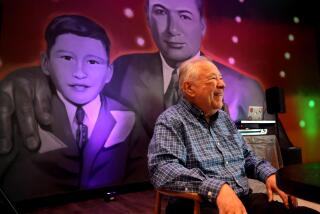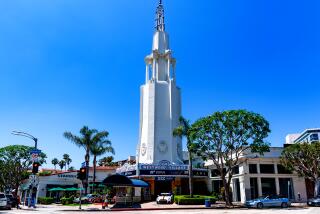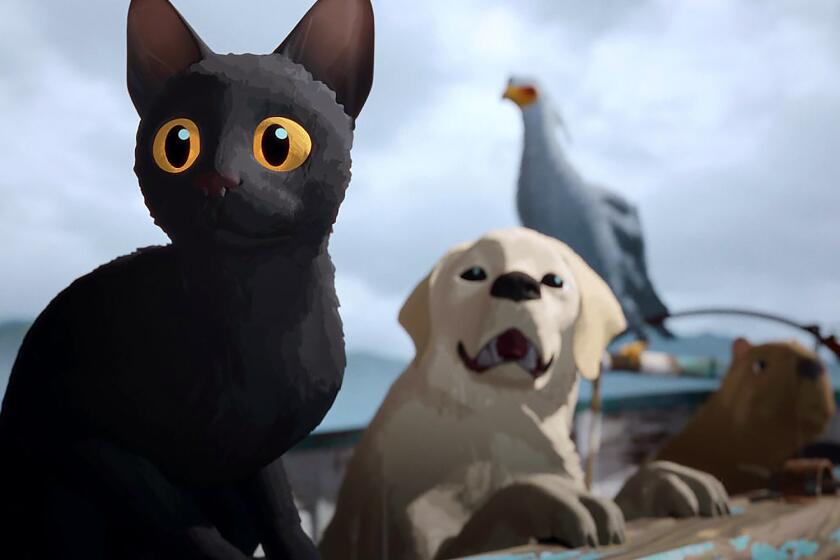Film Lover Mourns Demise of Balboa
I suppose it was just a matter of time. Anyone with a lick of business sense would know that a place like the Balboa Cinema wouldn’t--couldn’t--last forever. Honestly, all that valuable shorefront property on chic Balboa Peninsula being wasted by a boxy, musty old building that showed weird movies that sometimes only a handful of people would ever see.
Movies with odd names like “Erendira,” “Camila,” “Shoah” and “Europa Europa.”
So it’s with sadness, but not a great deal of surprise, that word arrived this week that the Balboa’s owner, Landmark Theatre Corp., can’t afford to renew its lease at the rates the property owner (Walnut Properties) is seeking. Consequently, the Balboa will close at the end of this month. What will rise from its ashes is unknown (Frozen Fish-Taco Yogurt Express?). Whatever it’ll be, the folks at Walnut aren’t saying, except that “People down there are going to love it.”
I hope so. But it’s difficult to imagine what kind of replacement will be quite as lovable as the drafty old Balboa to the legions of film aficionados who frequented it.
Of the dozens, maybe hundreds, of movies I’ve seen at the Balboa over the years, three leaped to mind when I heard that the venerable film house will run its final reel later this month.
One was “It’s a Wonderful Life,” which I saw on a big screen for the first time at the Balboa around Christmas in 1983. Having watched it so many times on television prior that I could recite the dialogue along with Jimmy Stewart (“That’s my trick ear, George--it sounded like you said, ‘No charge.’ ”), I was amazed at how different it felt to watch it the way it was intended--on the silver, not the TV, screen. One scene that hit me in an entirely new way was that of the pet black crow inside the office of Bailey Building & Loan. On TV, it was just a crow in the corner of the TV screen; in the theater, it was so much larger that it became a symbol of the inhumanity and greed that was personified by Mr. Potter, the Scrooge-like banker who couldn’t be bothered with such inconsequentials as human hopes and dreams.
I saw that back in the days when the Balboa was still a repertory house, specializing in classic and cult movies such as “Eraserhead,” “Casablanca,” Marx Brothers films and others that now live almost exclusively on videotape.
Once the VCR revolution sent such repertory houses the way of the knowledgeable department store clerk, the Balboa switched to foreign and so-called “art” films--usually imaginative and offbeat films shot on shoestring budgets with no-name casts. In other words, films of Kryptonite to the Supermen who book the big theater chains.
Another type of movie in equally short supply at the mall multiplex theaters is the Historically Important Film. A perfect example was “Shoah,” one of the other movies the Balboa’s death knell brought to mind. This was French director Claude Lanzmann’s 9 1/2-hour epic, in every sense of the word, about the Holocaust.
Landmark officials actually had to battle with the film’s distributor to bring it to Orange County in 1986 because the distributor had pegged the county as a WASP community that couldn’t care less about such an imposing documentary, especially one about the horrors of the Nazi extermination of Jews in World War II. (Not surprisingly, it didn’t set any box office records when it did play here. But then, that was never the idea. “This is one of those instances where money be damned,” Landmark co-owner Gary Meyer said at the time. “We’re going to go ahead and do it because we believe in ‘Shoah.’ And as a co-owner, I’m in a position to make a decision like that and pursue it.”)
After spending two marathon nights watching Lanzmann’s interviews with concentration camp survivors and some of the military officers who ran them, I remember thinking I would never understand how those who did survive managed to do so; but, more than I’d ever felt when the topic was addressed in school, I felt at least I’d begun to comprehend for the first time the magnitude of what they had survived.
In several ways, though, the movie that struck me as most representative of what the Balboa always was about is Akira Kurosawa’s “The Seven Samurai.”
Another marathon moviegoing adventure that lasted almost four hours, “The Seven Samurai” gave me--and perhaps other Orange County filmgoers--my first exposure to Kurosawa and to Japanese film. Previously I had imagined even a two-hour Japanese film would present a test of endurance.
But to my delight, I found Kurosawa’s classic adventure riveting from beginning to end--physical, philosophical, heartbreaking, affectionate and unexpectedly funny. I even dragged along my 13-year-old brother, who surprised me by enjoying it as much as I did.
The story itself is fitting--like the mavericks who have operated the Balboa these last 15 years (since it switched from its short run as a porno theater), the “Seven Samurai” of the title fought astonishing odds to preserve something that was endangered by hostile marauders who cared only about filling their purses and their stomachs.
Orange County movie lovers still have the Port Theatre in Corona del Mar, which is also owned by Landmark, and Edwards Cinemas, the Southland’s largest movie chain, which is showing art and foreign films fairly regularly at the South Coast Village theaters in Santa Ana.
But as that handful of samurai knew too well, even the loss of one of their brethren brought the threat of doom that much closer.
At the end of the movie, the village and its people were saved, although it cost the lives of some of the samurai they’d hired for protection. Walking away from the town as villagers celebrated victory, the head samurai grimly reminded one of his surviving compatriots that ultimately there is no victory for their kind--at best, only survival until the next battle.
“Again, we can’t win,” he says. With the demise of the Balboa Cinema, I feel the same way.
More to Read
Only good movies
Get the Indie Focus newsletter, Mark Olsen's weekly guide to the world of cinema.
You may occasionally receive promotional content from the Los Angeles Times.










